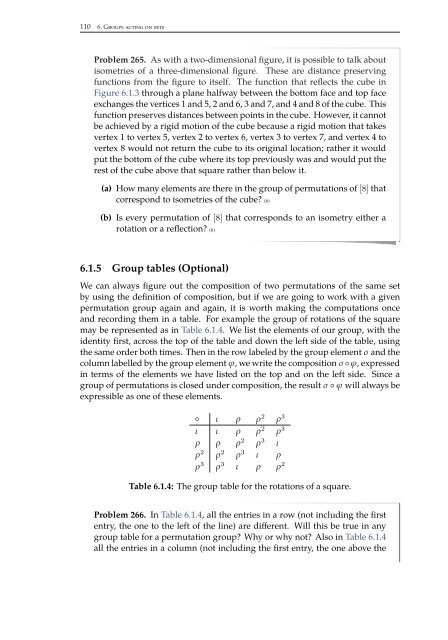Combinatorics Through Guided Discovery, 2004a
Combinatorics Through Guided Discovery, 2004a
Combinatorics Through Guided Discovery, 2004a
Create successful ePaper yourself
Turn your PDF publications into a flip-book with our unique Google optimized e-Paper software.
110 6. Groups acting on sets<br />
Problem 265. As with a two-dimensional figure, it is possible to talk about<br />
isometries of a three-dimensional figure. These are distance preserving<br />
functions from the figure to itself. The function that reflects the cube in<br />
Figure 6.1.3 through a plane halfway between the bottom face and top face<br />
exchanges the vertices 1 and 5, 2 and 6, 3 and 7, and 4 and 8 of the cube. This<br />
function preserves distances between points in the cube. However, it cannot<br />
be achieved by a rigid motion of the cube because a rigid motion that takes<br />
vertex 1 to vertex 5, vertex 2 to vertex 6, vertex 3 to vertex 7, and vertex 4 to<br />
vertex 8 would not return the cube to its original location; rather it would<br />
put the bottom of the cube where its top previously was and would put the<br />
rest of the cube above that square rather than below it.<br />
(a) How many elements are there in the group of permutations of [8] that<br />
correspond to isometries of the cube? (h)<br />
(b) Is every permutation of [8] that corresponds to an isometry either a<br />
rotation or a reflection? (h)<br />
6.1.5 Group tables (Optional)<br />
We can always figure out the composition of two permutations of the same set<br />
by using the definition of composition, but if we are going to work with a given<br />
permutation group again and again, it is worth making the computations once<br />
and recording them in a table. For example the group of rotations of the square<br />
may be represented as in Table 6.1.4. We list the elements of our group, with the<br />
identity first, across the top of the table and down the left side of the table, using<br />
the same order both times. Then in the row labeled by the group element σ and the<br />
column labelled by the group element ϕ, we write the composition σ ◦ ϕ, expressed<br />
in terms of the elements we have listed on the top and on the left side. Since a<br />
group of permutations is closed under composition, the result σ ◦ ϕ will always be<br />
expressible as one of these elements.<br />
◦ ι ρ ρ 2 ρ 3<br />
ι ι ρ ρ 2 ρ 3<br />
ρ ρ ρ 2 ρ 3 ι<br />
ρ 2 ρ 2 ρ 3 ι ρ<br />
ρ 3 ρ 3 ι ρ ρ 2<br />
Table 6.1.4: The group table for the rotations of a square.<br />
Problem 266. In Table 6.1.4, all the entries in a row (not including the first<br />
entry, the one to the left of the line) are different. Will this be true in any<br />
group table for a permutation group? Why or why not? Also in Table 6.1.4<br />
all the entries in a column (not including the first entry, the one above the


















